Introduction
‘Please keep a close eye on these animals’. This is the last line of the original Facebook post behind the furore surrounding allegations of Haitian residents of Springfield, Ohio, abducting and killing local pets and wildlife. Notably, after the user tells a (third-hand) tale of the skinning of a neighbourhood cat in graphic detail, they leave ample ambiguity in these final words. Whose vigilance are they calling upon and who, exactly, are they referring to when they say ‘animals’? Unperturbed by the xenophobic overtones and the lack of any shred of corroborating evidence, popular right-wing X user @EndWokeness released a tweet (Figure 1) that coupled a screenshot of the Facebook post with a nondescript photograph of a black man carrying a bird as he walked down the street. The accompanying text of the tweet implicitly linked the recent rise in Haitian immigration to Springfield with the supposed disappearance of pets and ducks. And thus, another anti-immigrant conspiracy theory was born.
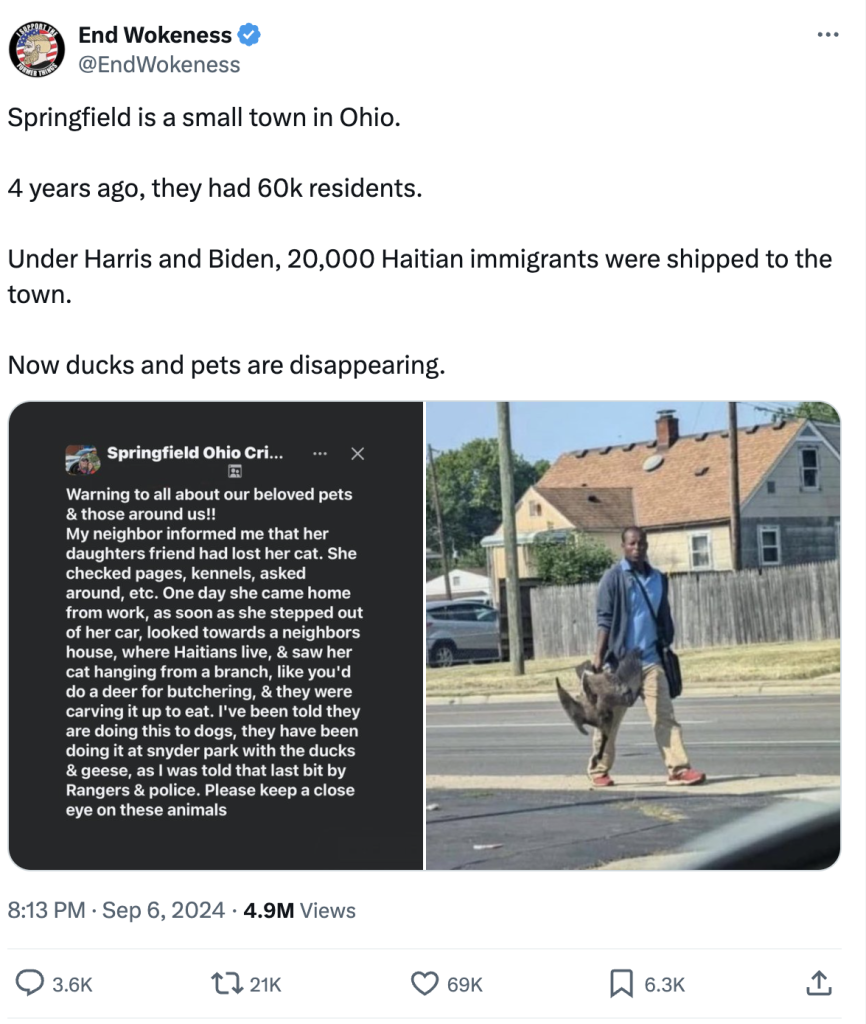
Although the story began as fodder for a local rumour mill, data shows that thanks to the awesome power of technology, literally tens of millions of people have heard about the so-called pet thieves of Springfield, and hundreds of thousands are talking about it, everyone from the presidential candidates to self-professed fascists. This Insight contends that the story’s massive reach is not without serious consequences for those in Springfield and beyond. In support of its claims of harm, the Insight first explores real-world harms – such as terroristic threats made against Springfield establishments and evidence that extremist groups have gathered in the city to engage in public shows of force. It then argues that the propagation of this Springfield story – refuted by all local officials – was never motivated by actual outrage over animal cruelty. Rather, online extremists have used it to reinforce xenophobic stereotypes writ large. They have used the narrative around Springfield to normalise and sanitise shifting public discourse from opposing illegal immigration to opposing most forms of immigration, vilify political opponents as un-American for supporting immigration, and, in extreme cases, promote the Great Replacement Theory, which justifies forced emigration of so-called ‘others.’
The Threat to Springfield
These recent claims about Haitians stealing, killing, and/or eating local pets and wildlife fit within a longer tumultuous history in Springfield. For context, according to the City of Springfield’s official website, approximately 15,000 immigrants now reside within Clark County (Springfield being its largest city), many being Haitians who have immigrated legally and hold Temporary Protected Status (TPS) as designated by the Department of Homeland Security. As Haitians only became TPS eligible in 2020 and census data collected that same year indicate a population of just under 60,000 people, the last four years have seen a notable change in the demographics of the city, and not without resultant tensions. In fact, last year, local outrage peaked both after a Haitian driver without an Ohio licence hit a school bus and resulted in the death of an 11 year-old and injured several others, and when a Springfield local pled guilty to federal hate crimes for assaulting eight Haitians on the basis of their nationality. Broadcasts from city council meetings show some constituents questioning whether the Haitian arrivals pose a threat to public safety, access to welfare programmes, and social cohesion. The leader of a small, local neo-Nazi group even warned a city commission meeting ‘Crime and savagery will only increase with every Haitian you bring in.’
Twisted irony though it may be, it appears the international publicity of this Haitian pet-eating conspiracy has proven to be an indisputable threat against the people of Springfield. In the days following the first rumblings of the conspiracy theory on X, two local hospitals, several local public schools, and multiple government buildings across the city have been evacuated or placed under lockdown due to bomb threats. According to a spokesperson for the city, emailed threats have been sent to multiple city commissioners and government employees. At present, with no sign of any such bombs, it is unclear if these threats even originated in the area or are instead the work of outside actors galvanised online.
Meanwhile, a representative of the Haitian community in Springfield also articulated serious fears among his compatriots that they will be targets of reactionary violence. There have been threats of a shooting spree targeting Haitians. Not only did the local neo-Nazis display access to firearms previously, it appears that online reports have incited Proud Boys, a Ku Klux Klan chapter, and other right-wing extremists to the point where they have shown up in Springfield. Meanwhile, X accounts known to endorse what they consider ‘guerrilla journalism’ have written to their several million combined followers to encourage them to investigate in Springfield; in some cases, accounts have even incentivised this behaviour with what may be characterised as a journalistic bounty for ‘evidence’ of Haitians eating pets and wildlife (Figure 2). With the online firestorm far from dissipating and a growing push to put boots on the ground to address the issue, it remains to be seen if this online conspiracy theory about animal cruelty results in real-world human brutality.

Existential Threat Beyond Springfield
With myriad conspiracy theories and viral news stories appearing on X every day, the national press’ focus on one particular rumour about Haitians in Springfield may seem surprising at first glance. However, the Springfield conspiracy has the component parts of a sensational social media story. The victims are pets and local wildlife, essentially innocent souls and, in the case of cats and dogs, beloved family members. The setting is the proverbial American Heartland, far from the urban centres commonly cited as the epicentres of vicious crime. Beyond even the maxim of ‘if it bleeds, it leads,’ there is also the additional flair of speculation about animal sacrifices for voodoo rituals.
What and how we eat has long been deemed a facet of our culture, and in this way, the story also fits into a long tradition in America of perpetuating conspiracy theories and racial stereotypes specifically about food designed to denigrate immigrant and/or non-white populations. American food historians have documented anti-Asian narratives that concentrated on their ‘unhygienic’ cuisine, including COVID-19 conspiracies; Mexican/South American immigrants are mocked using the slur ‘beaners’; Southeast Asian immigrants face ridicule for being ‘smelly,’ due to their cuisine; and a common feature in caricatures of the unsophisticated black American include their love of fried chicken and watermelon. In this case, the Springfield story represents a clear violation of American food taboos about food hygiene and against consuming commonly domesticated animals.
Like Schrodinger’s cat, the Springfield story is simultaneously so far-fetched and yet so viscerally disturbing that those seeking to leverage it politically have been able to do so on two levels. The first is the more superficial level of pop culture and absurdist online humour. For instance, conservative commentators have been working to ‘flip’ the negative press surrounding JD Vance’s comments about ‘cat ladies.’ (Figure 3)
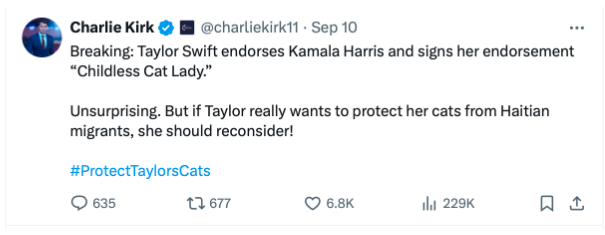
Injecting some absurdist levity to a presidential campaign cycle that often makes Election Day sound like Armageddon, Trump’s outburst at the debate has led ‘they are eating the dogs’ to trend on X, with thousands of tweets using a joking tone or companion photo to indicate a humorous interpretation of the Springfield conspiracy. As depicted below (Figures 4 & 5), AI-generated images painting the conspiracy in a humorous light have flooded X. Musicians have even literally written songs spoofing it.

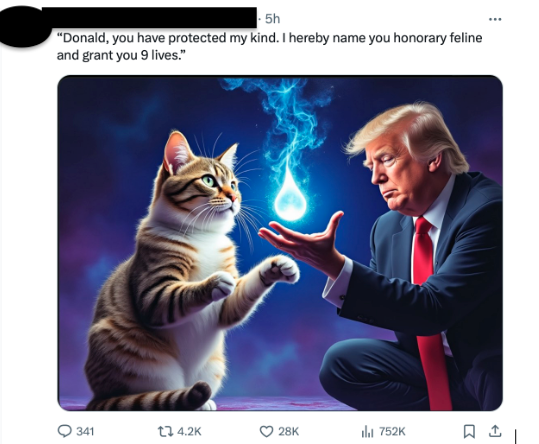
Although tweets using hashtags related to the Springfield conspiracy cannot be categorised as motivated by a single ideology – many criticised the narrative or mocked those who bought into it – as Tomi Lahren explained to her audience, Trump was ‘winning the week’ in part because ‘the memes are EVERYWHERE on social.’
The other part of the discourse about the Springfield conspiracy theory is far from funny. Despite flat denials from city officials that local pets had died under any suspicious circumstances, public engagement numbers indicate that literally millions of X users have read statements (Figure 6) about Haitians in American small towns ‘[practising] animal sacrifices and eating Americans’ pets’ or listened to Tucker Carlson say ‘it’s not that the pets are being eaten, it’s that they’re being sacrificed.’ Further fear mongering comes as accounts have extrapolated claims about animal consumption with migrant-perpetrated violence and impending cannibalism. In reaction to a critique of anti-Haitian rhetoric, a prominent Christian publisher posted ‘When you object to the pagan foreigners killing you, they will say you are evil and full of hate,’ while Alex Jones declared ‘Cannibalism is so prevalent in Haitis history that if they had a national mascot, it would be a human being cooked in a large cauldron.’ [sic]
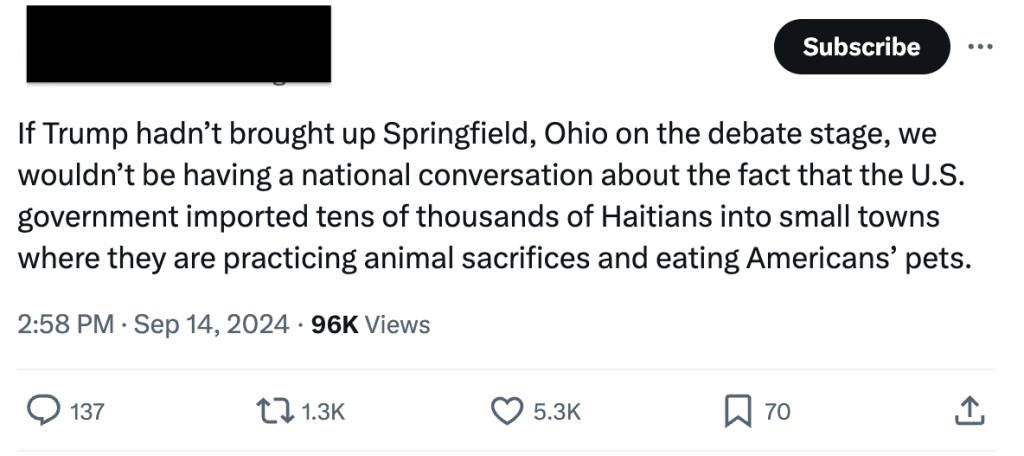
The xenophobia at play in the Springfield story extends well beyond that city or Haitian immigrants. Now, X users invoke Springfield before pivoting to other alleged or corroborated instances of immigrant violence or social discord. Springfield is now the rallying cry on X to justify the vilification of immigrants and pro-immigrant politicians as threats to Americans and American democracy. For example, Elon Musk tweeted linking the Democratic Party, Haiti, immigration policy, and implying a conspiracy around anti-democratic election manipulation. (Figure 7) Charlie Kirk said that ‘what’s happened to the residents of Springfield is criminal…Heads need to roll.’
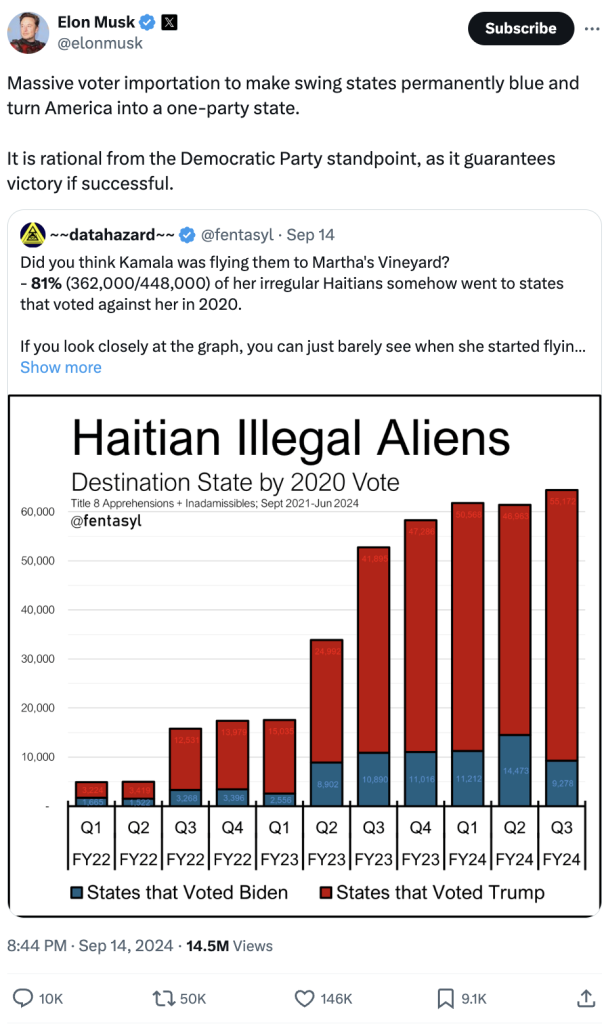
Veering even further, one right-wing commentator Lara Loomer pointed out, ‘Nobody wants to be replaced…Donald Trump will MASS DEPORT them!’ (Figure 8) Overt calls for Trump to impose remigration policies – essentially forced emigration often embraced by white nationalists – upon returning to power have been echoed on numerous verified X accounts in recent days. (Figure 9)

And these are no longer just the rhetoric and policy ideas of right-wing extremist trolls online. Former Senior Advisor to President Trump and current Trump campaign surrogate Stephen Miller wrote, ‘Kamala is mass importing illegals into every small town in America. She wants to turn your community into a third world refugee camp,’ and ‘THE TRUMP PLAN TO END THE INVASION OF SMALL TOWN AMERICA: REMIGRATION!’ Vice Presidential candidate Vance himself tweeted ‘“They are here legally,” they tell us…But Kamala Harris waving the magic amnesty wand is not a justification for the presence of 20,000 newcomers in Springfield. It is an indictment of her despicable open border…[It] is Kamala Harris who is a threat to democracy. It is Kamala Harris who would rather import new voters than persuade the ones who are already here.’ Trump himself went even further. He outright committed to some form of remigration policy with the Springfield conspiracy theory serving as a backdrop. (Figure 10)

Conclusion
Given that the CEO of X himself has been participating in the perpetuation of the Springfield conspiracy theory, there are inherent limits to what may reasonably be offered as a remedy. The fact-checking nature of community notes, for instance, must continue to help curb some disinformation/misinformation. Although there are many benefits to pseudo-citizen journalism, it also behoves X users to pause and contemplate the potential manipulation of their content. Will including a hashtag employed by extremists in a tweet disavowing them help fight misinformation, or will it further amplify it? Will audiences intrinsically know the context of the photo you want to post? In reality, both the original Facebook poster and the man behind the photo featured in the @EndWokeness tweet now express regret over what has become of their content. History teaches us that extremists have always and will always fabricate, exaggerate, or chase after stories that catch public attention. The trick has to be training ourselves not to take the bait. As one extreme X account admits: ‘They can debunk it all. Go ahead, call us racist bigots! We’re spreading misinformation!!!!! Because none of that even matters. It was never about the damn cat.’
